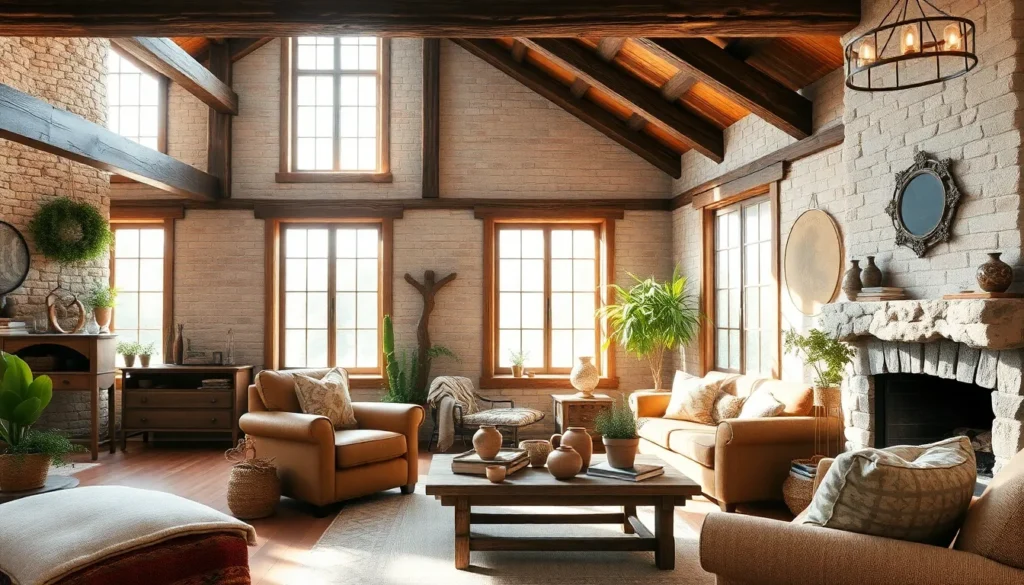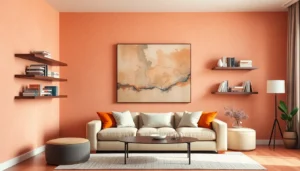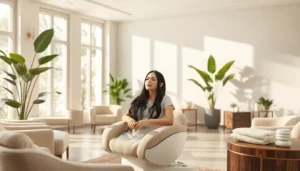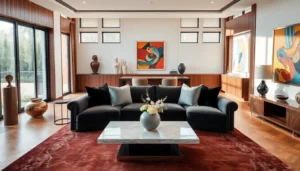Imagine stepping into a cozy cabin nestled in the woods, where the scent of pine and the warmth of a crackling fire instantly make you feel at home. Rustic interior design captures that inviting charm, blending natural elements with a touch of nostalgia. It’s like giving your living space a warm hug—who wouldn’t want that?
Table of Contents
ToggleWhat Is Rustic Interior Design?
Rustic interior design emphasizes simplicity and a connection to nature. This style incorporates raw materials like wood, stone, and metal, showcasing their natural textures and colors. Elements often include exposed beams, stone fireplaces, and reclaimed furniture, creating an authentic atmosphere.
Comfort features prominently in rustic designs. Cozy textiles such as wool, cotton, and burlap add warmth. Earthy color palettes, including browns, greens, and muted blues, mimic natural landscapes. Designers focus on functionality and warmth, ensuring every piece serves a purpose while contributing to the cozy environment.
A rustic space often tells a story. Heirloom pieces and vintage finds inject personality and history. The amalgamation of various elements fosters an inviting ambiance, perfect for relaxation and gatherings.
Sustainable practices frequently align with rustic principles. Many design choices prioritize eco-friendly materials and craftsmanship. Thrifted items and local artisans contribute to a lower environmental impact while enhancing individual character.
Open layouts define many rustic interiors. Spaces encourage flow and interaction among different areas. Natural light plays a crucial role, with large windows framing picturesque views and creating a calming atmosphere.
Ultimately, rustic interior design encompasses a lifestyle choice. It embraces the beauty of imperfections and celebrates the natural world. This approach fosters tranquility and encourages a deeper appreciation for the surroundings.
Key Elements of Rustic Interior Design
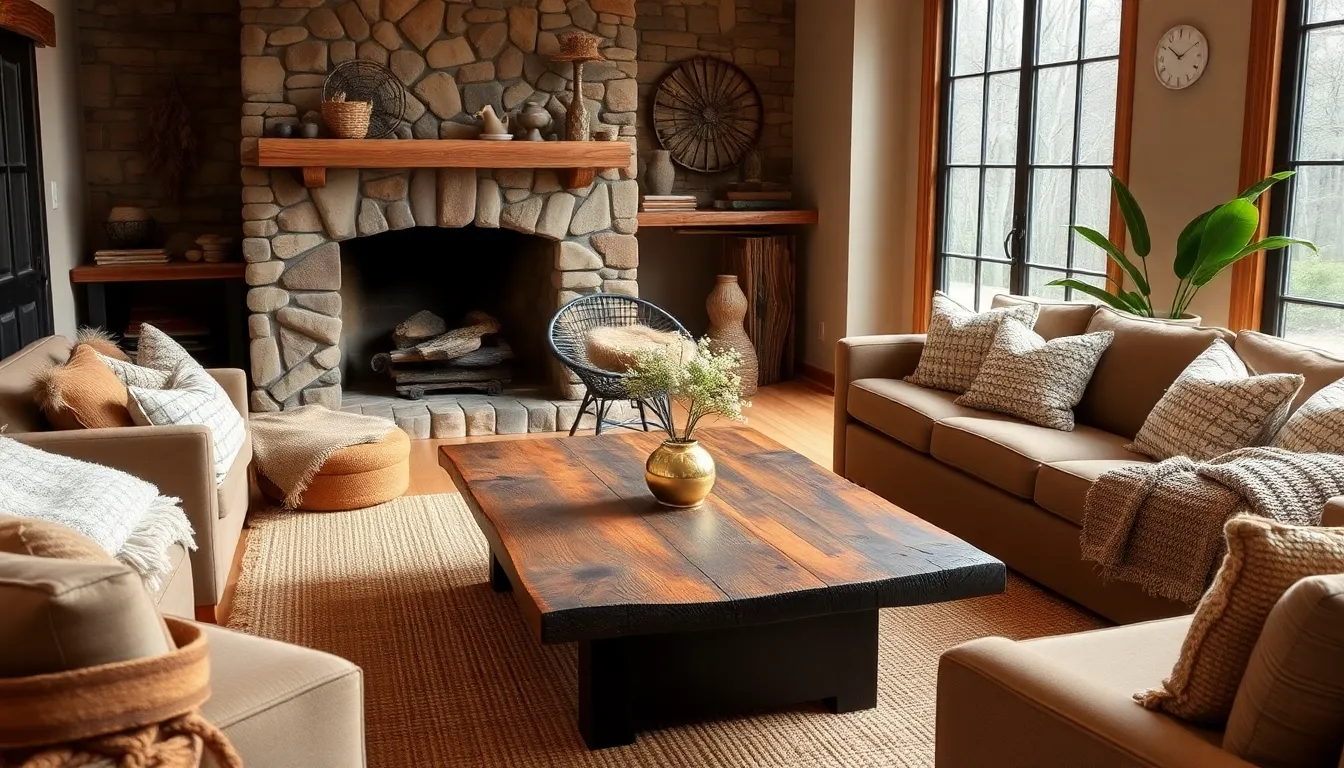
Rustic interior design thrives on the charm of natural elements, creating inviting spaces infused with warmth and authenticity. Several key elements define this style.
Natural Materials
Natural materials form the backbone of rustic design. Wood, stone, and metal play prominent roles in enhancing an organic feel. Reclaimed wood beams add character, while stone accents create a sense of sturdiness. Metal fixtures like wrought iron contribute to a vintage aesthetic. Furniture crafted from natural materials fosters an earthy connection, making each piece unique. Combining these materials fosters a balanced aesthetic, emphasizing simplicity.
Warm Color Palettes
Warm color palettes enhance the cozy vibe of rustic interiors. Earthy tones such as browns, greens, and muted reds evoke a sense of nature. Soft neutrals provide a backdrop that complements bolder accents. Using colors inspired by landscapes captures the essence of outdoor living. Layering shades creates depth and warmth in each room. Rustic spaces often utilize colors that mimic natural elements like wood grain and stone, adding to the inviting atmosphere.
Textures and Patterns
Textures and patterns add visual interest to rustic designs. Varied textiles such as wool, linen, and burlap introduce warmth and comfort. Layering these materials creates a tactile experience, encouraging relaxation. Natural fibers often showcase intricate patterns, contributing to the overall aesthetic. Incorporating stone and wood textures within design elements enriches the space. Mixing patterns, such as plaid or floral, enhances the rustic charm while keeping a cohesive look.
Rustic Interior Design Ideas for Different Rooms
Rustic interior design enhances each room by incorporating natural elements and warm aesthetics. Below are ideas tailored for various spaces.
Living Room
A cozy living room invites relaxed gatherings. Incorporating reclaimed wood for beams or furniture adds character. A stone fireplace serves as a focal point, offering warmth and charm. Layered textiles, including wool and cotton, contribute comfort for family and friends. Earthy tones on walls and décor create a soothing atmosphere. Vintage finds like eclectic furnishings can highlight personal stories. Natural light through large windows amplifies the inviting feel.
Kitchen
The rustic kitchen merges functionality with charm. Wooden cabinetry exudes warmth and character, often using reclaimed materials. Open shelving showcases beautiful dishware, bridging practicality with aesthetics. Copper pots or cast iron pans hang as decorative elements while remaining useful. Farmhouse sinks add a touch of nostalgia. Textured fabrics in curtains or table runners soften the space and embrace warmth. A warm color palette ties the entire kitchen together, evoking a sense of comfort.
Bedroom
A rustic bedroom promotes tranquility and rest. Incorporating wood elements like a log bed frame creates a focal point. Cozy textiles such as burlap or linen for bedding enhance comfort. Accent pillows in earthy colors invite relaxation while adding visual interest. Reclaimed furniture pieces, like nightstands or dressers, can elevate the aesthetic. Natural light through large windows connects the space to nature. Vintage lamps or artwork offer unique charm and storytelling through décor.
Bathroom
Rustic bathroom designs emphasize natural materials for a spa-like atmosphere. Stone tiles on the floors or walls provide authenticity and texture. A freestanding tub surrounded by plants creates a serene escape. Wood accents, such as reclaimed wood shelves, offer warmth while serving practical purposes. Earthy tones in paint or décor maintain a cohesive, calming space. Incorporating mason jars for storage harmonizes functionality with a rustic look. Large mirrors can enhance light and the sense of space, making the bathroom inviting.
Tips for Achieving a Rustic Look
Embrace natural materials to enhance the rustic vibe. Using reclaimed wood for flooring or furniture establishes authenticity and warmth. Consider incorporating stone accents to create an inviting focal point, such as a stone fireplace or feature wall.
Select a warm color palette to evoke a sense of nature. Earthy tones like deep browns, greens, and soft grays reflect outdoor landscapes. Layering different shades adds depth and invites comfort.
Utilize varied textures to enrich the space. Complement rough wood with soft fabrics, like cozy wool or cotton. Burlap pillows and linen throws introduce tactile contrast, enhancing a comfortable environment.
Invest in vintage or heirloom pieces to tell a story through decor. Antique finds can serve as conversation starters, connecting the space to history. Choose furniture and accessories with character, showcasing their imperfections rather than hiding them.
Maximize natural light to create openness in the room. Large windows allow sunlight to flood in, enhancing the connection to nature. Position mirrors strategically to reflect light, making spaces feel bigger and brighter.
Incorporate greenery to bring the outdoors in. Potted plants and fresh flowers add life and color, enriching the overall aesthetic. Use rustic containers like wooden or metal planters for a cohesive look.
Encourage an open layout to foster interaction. Flowing spaces promote togetherness, ideal for gatherings and relaxation. Arrange furniture to facilitate conversation, grouping seating near focal points like the fireplace.
Rustic interior design offers a unique blend of warmth and authenticity that resonates with those seeking comfort and connection to nature. By incorporating natural materials and earthy color palettes, anyone can create inviting spaces that encourage relaxation and interaction. The charm of rustic design lies in its ability to tell a story through vintage finds and heirloom pieces, enriching the home with character and nostalgia. Embracing these elements not only enhances the aesthetic but also fosters a lifestyle that values simplicity and sustainability. Ultimately, rustic design transforms living spaces into havens of tranquility, making them perfect for both quiet moments and lively gatherings.
